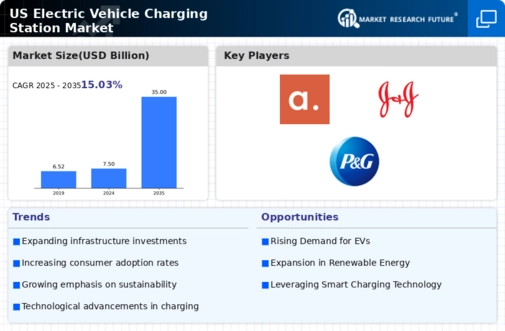The electric vehicle-charging-station market is currently characterized by a dynamic competitive landscape, driven by increasing consumer demand for electric vehicles (EVs) and a growing emphasis on sustainability. Major players such as Tesla (US), ChargePoint (US), and Electrify America (US) are at the forefront, each adopting distinct strategies to enhance their market presence. Tesla (US) continues to innovate with its proprietary Supercharger network, focusing on expanding its infrastructure to support its growing fleet of vehicles. ChargePoint (US), on the other hand, emphasizes partnerships with various businesses and municipalities to increase accessibility and convenience for EV users, thereby enhancing its competitive positioning. Collectively, these strategies contribute to a rapidly evolving market environment, where innovation and accessibility are paramount.
In terms of business tactics, companies are increasingly localizing manufacturing and optimizing supply chains to reduce costs and improve efficiency. The market appears moderately fragmented, with numerous players vying for market share, yet the influence of key players remains substantial. This competitive structure fosters an environment where collaboration and strategic partnerships are essential for growth, as companies seek to leverage each other's strengths to enhance their offerings.
In October 2025, Tesla (US) announced the expansion of its Supercharger network by adding 1,000 new charging stations across the United States. This strategic move is likely to bolster Tesla's market dominance, as it not only increases the convenience for Tesla owners but also positions the company as a leader in charging infrastructure, potentially attracting more EV users. Furthermore, this expansion aligns with the broader trend of enhancing charging accessibility, which is crucial for the widespread adoption of electric vehicles.
In September 2025, ChargePoint (US) entered into a partnership with a major retail chain to install charging stations at over 500 locations nationwide. This collaboration is indicative of ChargePoint's strategy to integrate charging solutions into everyday consumer experiences, thereby increasing the visibility and usage of EV charging stations. Such partnerships may enhance ChargePoint's competitive edge by making charging more convenient and accessible to a broader audience.
In August 2025, Electrify America (US) launched a new initiative aimed at integrating renewable energy sources into its charging stations. This initiative not only underscores Electrify America's commitment to sustainability but also positions the company favorably in a market increasingly focused on environmental impact. By utilizing renewable energy, Electrify America may attract environmentally conscious consumers, thereby enhancing its market appeal.
As of November 2025, current trends in the electric vehicle-charging-station market are heavily influenced by digitalization, sustainability, and the integration of artificial intelligence (AI) into operations. Strategic alliances are becoming increasingly vital, as companies recognize the need to collaborate to enhance their technological capabilities and market reach. Looking ahead, competitive differentiation is likely to evolve from traditional price-based competition to a focus on innovation, technology, and supply chain reliability. This shift suggests that companies that prioritize these aspects will be better positioned to thrive in an increasingly competitive landscape.

















Leave a Comment